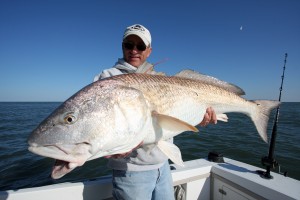 There probably is not another place better for catching big red drum than the Outer Banks of North Carolina and the Chesapeake Bay area of Virginia. Many large drum in the bay are caught by flounder, cobia, and striper fishermen. There are three, consistent, directed fisheries for large reds in Virginia. The first usually begins in early May along our barrier islands and in the shallow waters of Magothy Bay. Surf casting from the islands, in the spring and fall, is very productive for both red and black drum. When conditions are right, sight casting spoons to schools of reds can be effective in Magothy Bay.
There probably is not another place better for catching big red drum than the Outer Banks of North Carolina and the Chesapeake Bay area of Virginia. Many large drum in the bay are caught by flounder, cobia, and striper fishermen. There are three, consistent, directed fisheries for large reds in Virginia. The first usually begins in early May along our barrier islands and in the shallow waters of Magothy Bay. Surf casting from the islands, in the spring and fall, is very productive for both red and black drum. When conditions are right, sight casting spoons to schools of reds can be effective in Magothy Bay.
The easiest way to catch citation size red drum ( 46″ release ) occurs from mid-May through June. During this time, drum averaging 25-50 lbs. roam the shoals at the mouth of the bay. Latimer Shoal and the shallow water near the northern section of the CBBT are where most of the fish are caught. During the day, these fish can be caught by trolling spoons over and around the shallow water. The basic rig consist of an in-line sinker followed by a long (15-25 foot) leader of about 80 lb test. The leader is tied directly to the spoon. The sinker is in the 6-12oz range. 3 1/2 Drones, Pet, or similar spoons are good. If you have wire line rigs, just put a spoon in place of the bucktail. Let out a good amount of line and troll slowly around the shoal area. At night, anchor up on top of the shoal and set out your lines. Use fish finder rigs with 6oz sinkers. To hold them in the current, use pyramid sinkers on the lines you will cast to the sides of the boat. The leader is in the 60-80lb test range and needs to be short enough for casting. Hooks are 7/0-8/0 with long shanks for peeler crab. Short shank hooks and circle hooks work fine with cut bait. The best bait is peeler crab, if there are not too many bait stealers. Pop off the top shell of the crab and cut it in two. Thread the hook in through a leg joint and into the meat of the crab. Use a rubber band to attach the legs of the crab to the shank of the hook. Fresh cut spot and menhaden will stay on the hook better when bait stealers are around. Cast out your lines and put the rods in the rod holders. The reels are in gear, with fairly light drags, clickers on.
The third main fishery occurs in August and September in the waters off of Cape Charles. Favorite areas are the mussel bed north of buoy 36A and the ledge near 42A. Fish in 20-40 feet of water. The fishing seems to be best from late afternoon through dark. These fish run big, with fish over 50 pounds common.
